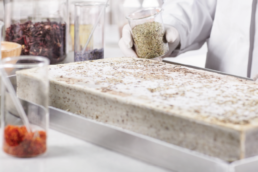3D bioprinting has advanced significantly over the past decade. The sector has quickly become one of the leading segments in the 3D printing industry when it comes to innovation. Furthermore, the global bioprinting market is expected to reach over $4 billion by 2027.
What is 3D Bioprinting?
Bioprinting utilizes proteins, living cells, and biomaterials to create biological materials. 3D printing, in general, distributes different materials left and right, up and down, and backward and forwards, to print an item layer by layer. 3D bioprinting uses living cells and biomaterials to print living structures layer by layer to create a natural living product. Therefore, 3DV bioprinters can build complex structures such as blood vessels and skin tissue.
Previously, most bioprinting applications were used in the medical industry only. However, more and more industries are looking into 3D Bioprinting for innovative solutions. The reason for this is that 3D bioprinters have become a lot more sophisticated. They are able to deliver cells with high survivability and high precision. This is why many biotech companies, laboratories, hospitals, and universities around the world are exploring this field.
How Industries Can Benefit From 3D Bioprinting Technology
3D bioprinting has become a very hot trend for many industries. This is because it offers a precise and controlled layer-by-layer assembly of biomaterials in whatever 3D pattern is desired. The capabilities of 3D bioprinting are vast so industries not just in medicine should be looking to incorporate this innovative technology.
1. 3D Bioprinting for the Medical Industry
3D bioprinting allows you to print biomedical parts that have the same properties as natural tissues. The ultimate goal is to eventually print a fully functional human organ. As the demand for organ transplants continues to grow every year, the solution that 3D bioprinting can bring becomes critical. Many researchers in the bioprinting industry feel that within 20 years, transplant waiting lists will no longer exist. Currently, over 114,000 patients are waiting for an organ transplant in the United States. With 3D bioprinting technology, patients will have access to an organ that would be created from the very cells of their body.
Regenerating Organs through 3D bioprinting
South Korean biotech startup ROKIT Healthcare has been investigating ways to regenerate organs through 3D bioprinting to provide solutions for chronic diseases. Diseases related to skin, cartilage, and kidneys still lack treatments, which is why ROKIT focuses its research specifically on these areas. The company is currently undergoing clinical trials for regenerating cartilage in Egypt, after finishing animal testing at Massachusetts General Hospitals. Furthermore, the company has been leading the industry with its innovative 3D bioprinter DR. INVIVO which allows precise prints of various biomaterials like biopolymers and hydrogels. Together with the Hycare Super Speciality Hospital in India, ROKIT managed the treatment of diabetic foot ulcers through its customized tissue regeneration platform.
ROKIT states that “using ROKIT’s 4D bioprinting system with a patient’s autologous fat tissue, diabetic foot ulcers were successfully healed after getting only one treatment during the clinical trials”. This could also benefit other skin regeneration treatments, like wound healing or scar treatments.
2. 3D Bioprinting for the Alternative Meat Industry

One of the hottest-growing industries for 3D bioprinting is the alternative meat industry. There is a race to create meat products that are not only more sustainable than animal meats but also just as delicious. US meat giant, Tyson Foods invested in the cell-based meat firm Memphis Meats and an Israel-based lab Future Meat Technologies.
KFC is partnering with a bioprinting company to create chicken nuggets that have the signature KFC taste and texture. Compared to traditional farming methods, bioprinted nuggets would be more animal friendly, as the food does not consist of any real meat. Additionally, the process would also benefit the reduction of greenhouse gases. Currently, KFC is already creating vegetarian chicken nuggets using Beyond Meat’s plant-based chicken products.
3. 3D Bioprinting for the Beauty Industry
The research into 3D bioprinting for skin tissue promises innovative solutions in the beauty industry. This includes creating skin samples faster, cheaper, and more ethical for makeup and product testing. 3D bioprinting company Organovo partnered with L’Oreal to produce over 100,000 skin samples per year. The advantage of the beauty industry is the ability to create ethical test products across a variety of skin types for accurate results.
Furthermore, ROKIT Healthcare believes that the best solution to fight anti-aging lies within the human body itself. The startup has been intensively researching anti-aging solutions in hair regeneration, diet management, and beauty care.
4. 3D Bioprinting for the Space Industry
Elon Musk has revitalized the space industry with his company Space X. However, there are many challenges to overcome. The European Space Agency (ESA) has been looking into 3D bioprinting to support the medical treatment of long-duration space expeditions as well as planetary settlements. 3D bioprinting technology can offer treatment options for accidental injuries that might occur in space. Being able to regrow body tissue, skin, bone, and cartilage quickly in a confined space will be crucial in this treatment process. In addition, cell-based tissue samples can be used to study the impact of space radiation.
5. 3D Bioprinting for the Fashion Industry

Leather has been a staple in the fashion industry for decades. Imagine being able to print out leather without having to kill a cow. This kind of ” biofabrication” requires less water, energy, and land to produce the same amount of leather as current production methods do. Plus there is the advantage of eliminating animal cruelty.
A US startup called Modern Meadow has created a material that is made of collagen which is the main structural ingredient in natural animal skin. Their aim is to make their material superior to real leather by making it stronger and more elastic.
Sponsored by ![]()
Popular
Related Posts






